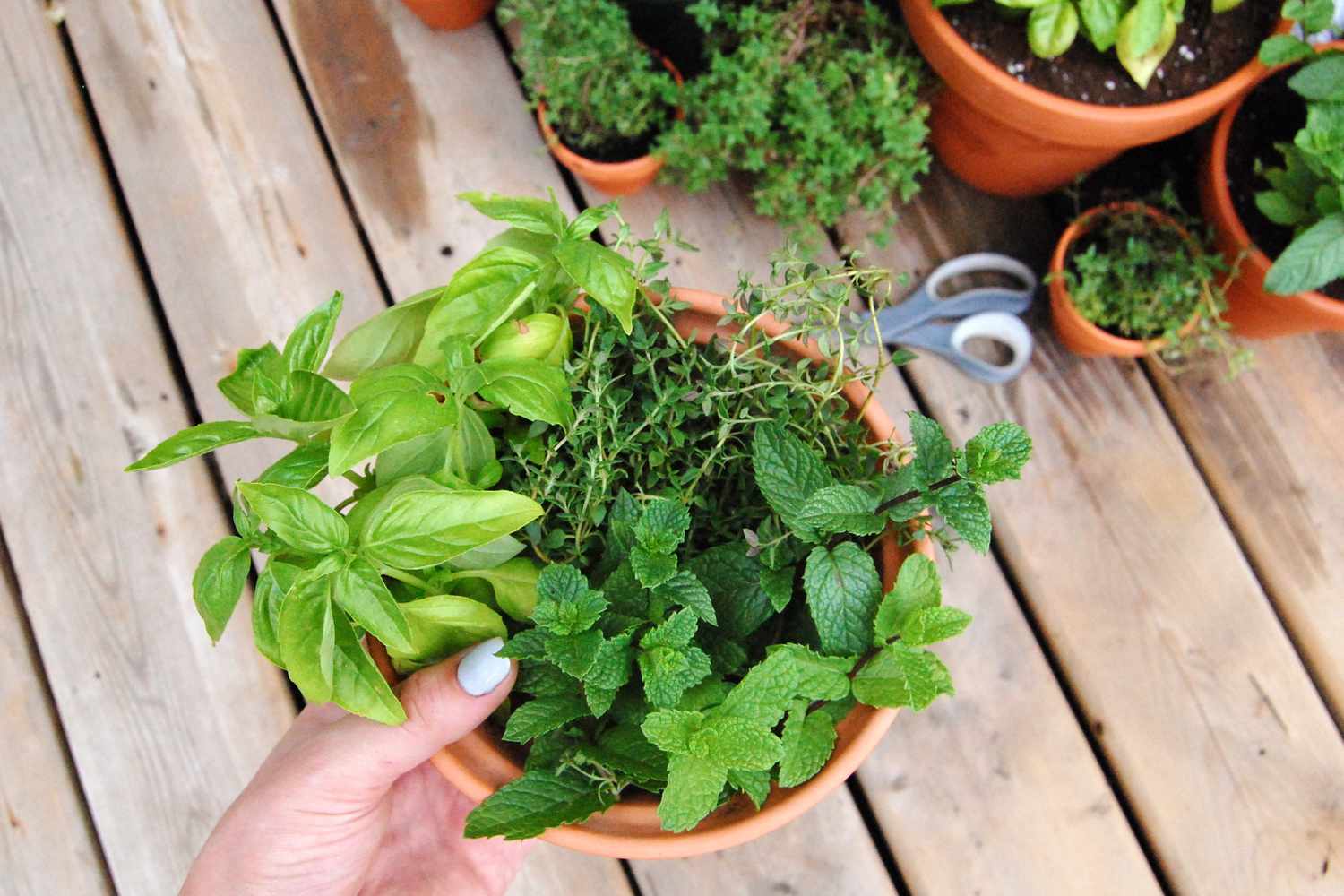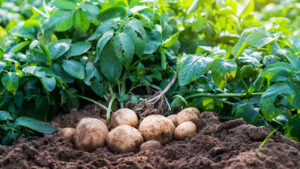How to Store Fresh Garden Herbs: Complete Guide
Nothing elevates home cooking like fresh herbs from your own garden. The aromatic flavors of basil, mint, rosemary, and other culinary favorites can transform ordinary dishes into extraordinary meals. But perhaps the most challenging aspect of growing your own herbs is knowing how to properly store them to maximize their flavor and shelf life after harvest.
In this comprehensive guide, you’ll discover the best methods for storing your homegrown herbs, keeping them fresh longer, and preserving their flavors for year-round enjoyment. Whether you have a sprawling herb garden or a few potted plants on your windowsill, these techniques will help you make the most of your herb harvest.
Understanding Herb Storage Basics
Before diving into specific storage methods, it’s important to understand what causes fresh herbs to deteriorate. Fresh herbs begin to lose their flavors and aromas as soon as they’re harvested due to:
- Natural oils evaporating
- Enzyme activity breaking down plant tissues
- Moisture loss causing wilting
- Bacterial growth causing rot
According to the USDA Food Safety and Inspection Service, proper storage temperature and moisture control are crucial factors in extending herb freshness. The key to successful herb storage lies in slowing these processes through proper handling techniques and storage conditions.
Types of Herbs and Their Storage Requirements
Not all herbs are created equal when it comes to storage. Herbs generally fall into two categories: soft herbs and hardy herbs.
Soft Herbs
Soft herbs have tender stems and delicate leaves. They typically require refrigeration and special handling:
- Basil
- Cilantro
- Parsley
- Mint
- Dill
- Chervil
- Tarragon
Hardy Herbs
Hardy herbs have woody stems and firmer leaves. They’re often more forgiving in storage:
- Rosemary
- Thyme
- Sage
- Oregano
- Marjoram
- Bay leaves
- Lavender
Understanding these differences is critical because each type requires a slightly different approach to maintain optimal freshness and flavor.
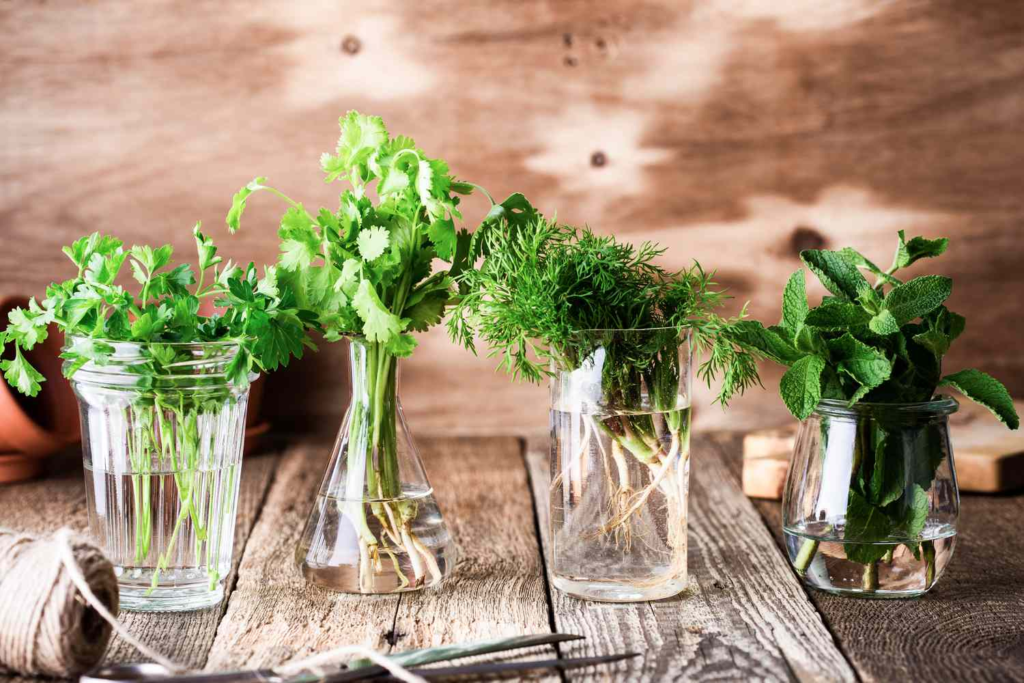
Short-Term Storage Solutions for Fresh Herbs
When you need your herbs to stay fresh for a few days to a week, these methods will help maintain their quality:
The Water Method (Best for Soft Herbs)
This method works exceptionally well for basil, cilantro, parsley, and mint:
- Trim the bottom of the stems (as you would with fresh flowers)
- Fill a glass jar with 1-2 inches of fresh water
- Place herb stems in the water like a bouquet
- Cover loosely with a plastic bag (except for basil—more on that below)
- Store in the refrigerator (except basil)
- Change water every 2-3 days
Special note for basil: Basil is sensitive to cold temperatures and will blacken in the refrigerator. Keep your basil bouquet at room temperature, out of direct sunlight.
The Damp Paper Towel Method (Versatile for Most Herbs)
This technique works well for both soft and hardy herbs:
- Gently wash and thoroughly dry herbs (a salad spinner works well)
- Lay herbs in a single layer on a slightly damp paper towel
- Roll up the paper towel loosely, enclosing the herbs
- Place the roll in a resealable plastic bag or container
- Store in the refrigerator’s crisper drawer
The Herb Keeper Method
Specialized herb keeper containers are designed to keep herbs fresh longer:
- Fill the container’s base with water
- Place herbs in the provided basket
- Change water every few days
- Store in the refrigerator (except for basil)
These devices typically provide a controlled humid environment that slows wilting while preventing the herbs from sitting in water and rotting.
Long-Term Herb Preservation Methods
When your garden produces more herbs than you can use immediately, these preservation techniques will help you enjoy your harvest year-round:
Freezing Fresh Herbs
Freezing preserves much of the flavor of fresh herbs, though the texture will change, making them best for cooked dishes:
Oil Method
- Chop clean, dry herbs finely
- Pack herbs into ice cube trays
- Cover with olive oil or melted butter
- Freeze until solid
- Transfer cubes to freezer bags
- Label with herb type and date
Water Method
- Chop herbs finely
- Fill ice cube trays halfway with herbs
- Cover with water
- Freeze until solid
- Transfer to freezer bags
- Label with herb type and date
Blanching Method (Best for Woody Herbs)
- Blanch herbs in boiling water for 15 seconds
- Shock in ice water
- Dry thoroughly
- Place in freezer bags
- Remove as much air as possible
- Label and freeze
Drying Fresh Herbs
Drying concentrates herb flavors and is especially effective for woody herbs:
Air Drying
- Bundle 5-10 stems together with twine
- Hang upside down in a warm, dry, well-ventilated area
- Cover with a paper bag with holes punched in it to catch falling leaves
- Allow to dry for 1-4 weeks until completely brittle
- Store in airtight containers away from light
Oven Drying
- Place herbs in a single layer on a baking sheet
- Set oven to lowest setting (preferably under 180°F)
- Leave door slightly ajar to allow moisture to escape
- Check every 30 minutes until completely dry
- Store in airtight containers
Food Dehydrator Method
- Lay herbs in a single layer on dehydrator trays
- Set temperature between 95-115°F
- Dry for 1-4 hours until completely brittle
- Store in airtight containers
Microwave Drying
- Place herbs in a single layer between paper towels
- Microwave on high for 30-second intervals
- Check after each interval until completely dry
- Allow to cool before storing
Storage Duration Guide
Here’s a handy reference table for how long you can expect your herbs to last with different storage methods:
| Storage Method | Soft Herbs | Hardy Herbs | Notes |
|---|---|---|---|
| Water Method (Refrigerated) | 1-2 weeks | N/A | Change water every 2-3 days |
| Water Method (Room Temp) | 3-7 days | N/A | Best for basil only |
| Paper Towel Method | 1-2 weeks | 2-3 weeks | Check moisture levels periodically |
| Herb Keeper | 2-3 weeks | 3-4 weeks | Follow manufacturer instructions |
| Frozen in Oil | 6 months | 6 months | Best used in cooked dishes |
| Frozen in Water | 6 months | 6 months | May lose some flavor intensity |
| Air Dried | N/A | 1-2 years | Store in cool, dark place |
| Oven/Dehydrator Dried | 6-12 months | 1-3 years | Must be completely dry before storage |
Creative Ways to Use and Preserve Herb Flavors
Beyond basic storage, these methods allow you to capture herb flavors in different forms:
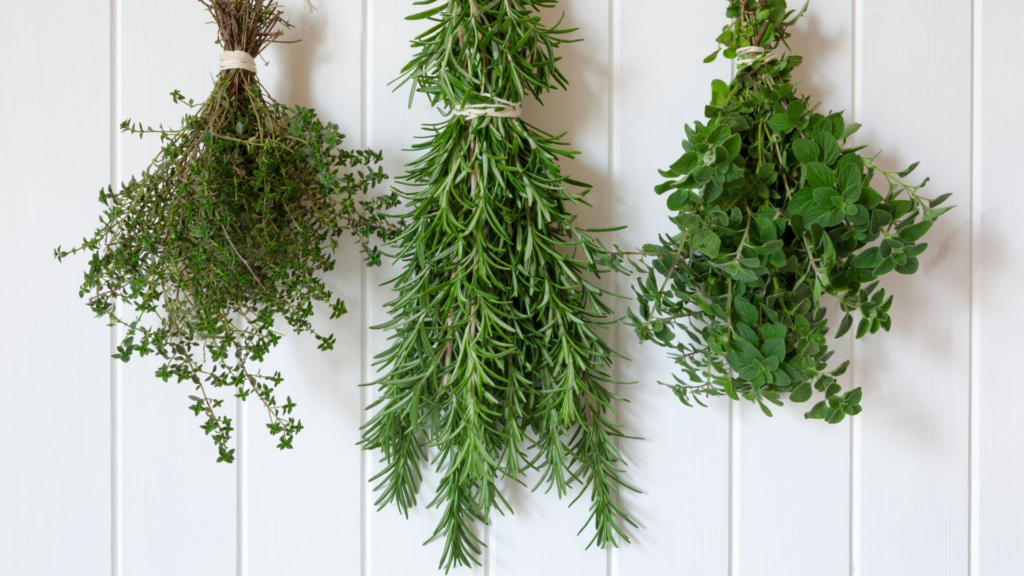
Herb-Infused Oils
- Wash and thoroughly dry herbs
- Gently warm oil (olive, grapeseed, etc.) to 140°F
- Add herbs and remove from heat
- Allow to steep for 1-2 hours
- Strain out herbs
- Store oil in refrigerator for up to 2 weeks
Safety note: Homemade herb oils can develop harmful bacteria if not properly prepared. The CDC recommends refrigerating herb-infused oils and using them within 2-4 days. For longer storage, commercial acidification methods are required.
Herb Butters (Compound Butters)
- Soften butter to room temperature
- Mix in finely chopped fresh herbs (1/4 cup herbs to 1 stick butter)
- Add salt and pepper if desired
- Roll into a log using parchment paper
- Refrigerate for up to 2 weeks or freeze for up to 6 months
Herb Vinegars
- Heat vinegar to just below boiling
- Place clean, dry herbs in sterilized bottles
- Pour hot vinegar over herbs
- Seal tightly and store in a cool, dark place
- Allow to infuse for 2-4 weeks
- Strain if desired and rebottle
- Use within 6-12 months
Herb Salts
- Layer fresh herbs with kosher salt
- Allow to dry for 1-2 weeks, turning occasionally
- Pulse in food processor until desired consistency
- Store in airtight container for up to 1 year
Troubleshooting Common Herb Storage Problems
Even with the best storage techniques, problems can arise. Here’s how to address common issues:
Wilting
- Cause: Moisture loss
- Solution: Rehydrate by trimming stems and placing in water for 30 minutes to 1 hour
Blackening/Browning
- Cause: Cold damage or ethylene exposure
- Solution: Store basil at room temperature; keep herbs away from ethylene-producing fruits like apples and bananas
Molding
- Cause: Excess moisture and poor air circulation
- Solution: Ensure herbs are dry before storing; don’t wash until ready to use; provide adequate ventilation
Flavor Loss
- Cause: Age, improper storage, temperature fluctuations
- Solution: Use herbs as fresh as possible; store properly according to herb type; maintain consistent storage temperatures
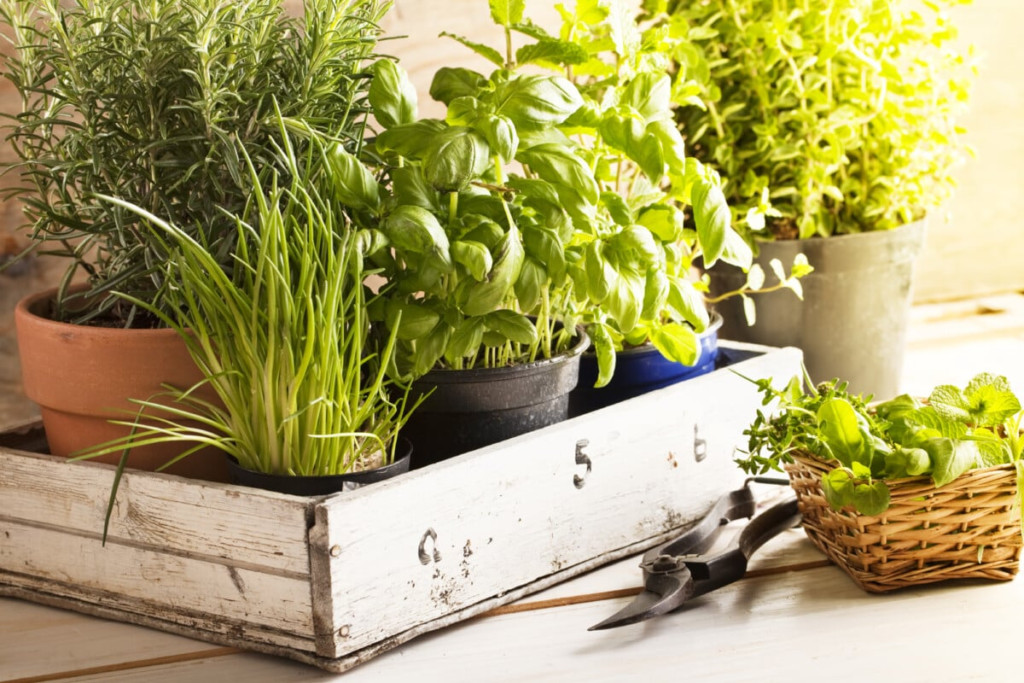
Herb Storage by Specific Variety
While we’ve covered general principles, here are specific recommendations for popular culinary herbs:
Basil
- Best short-term: Water method at room temperature
- Best long-term: Frozen in oil cubes or made into pesto
- Special considerations: Extremely cold-sensitive; turns black in refrigerator
Cilantro/Parsley
- Best short-term: Water method in refrigerator
- Best long-term: Frozen in water or oil cubes
- Special considerations: Stems can be more flavorful than leaves in some dishes
Mint
- Best short-term: Water method in refrigerator
- Best long-term: Air drying or freezing whole leaves
- Special considerations: Spreads rapidly in garden; consider container growing
Rosemary/Thyme/Sage
- Best short-term: Paper towel method
- Best long-term: Air drying or oven drying
- Special considerations: Extremely flavorful when dried; use sparingly
Dill
- Best short-term: Water method in refrigerator
- Best long-term: Freezing (maintains flavor better than drying)
- Special considerations: Very delicate; handle with care
Chives
- Best short-term: Paper towel method
- Best long-term: Freezing (snip into small pieces first)
- Special considerations: Loses flavor when dried; freezing is preferable
Conclusion
With these storage techniques in your culinary arsenal, you’ll be well-equipped to make the most of your herb garden harvest. Whether you’re storing herbs for a few days or preserving them for the winter months, proper storage ensures you’ll always have flavorful herbs at your fingertips.
Remember that the best storage method depends on the specific herb and how you plan to use it. Experiment with different techniques to find what works best for your favorite herbs and cooking style.
By investing a little time in proper herb storage, you’ll reduce food waste, save money, and elevate your cooking with garden-fresh flavors all year long. Your taste buds—and dinner guests—will thank you for the effort!
